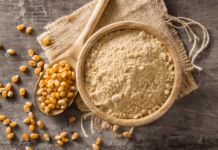Last Updated on September 18, 2021 by April
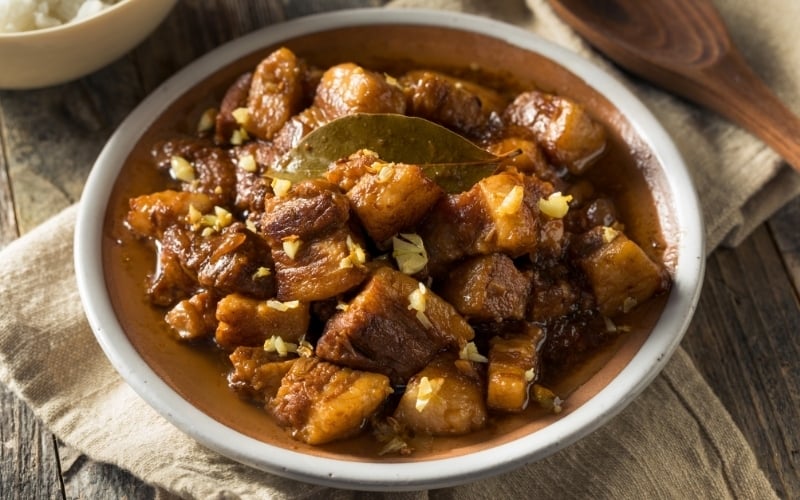
It’s true that Filipino food is best known for its dish called adobo. But there are so many more delicious dishes in the country too! In this post, we’ll be exploring some of the tastiest and most popular recipes from different regions of the Philippines. These include specialties like pansit, sisig, sinigang, lechon kawali, lumpia, and arroz caldo – a type of rice porridge made with ginger and chicken broth.
Pinoy cuisine is something that has always been near and dear to my heart. Being half Filipina with a Filipino mother, I was raised on a lot of these delicious foods. You bet I have tried all of these foods at some point, and I am excited to share my favorites with you. So let’s get started!
Common Filipino Ingredients
These are some basic Pinoy cooking staples that you should keep in your pantry. Each of these ingredients is used often in Pinoy dishes and is important to the overall flavor.
- Rice
- Tomato
- Fish Paste
- Pancit/Noodles
- Pork
- Vinegar
- Coconut
- Ube
Pinoy Meal Composition
What’s in a typical Filipino meal?
Ulam = Main Dish (meat + vegetables)
- Rice
- Vegetables
- Fruits
- Meat
Easy Filipino Recipes
Here are the best Pinoy recipes for beginners and seasoned Filipino dish eaters alike. Whether you are looking to dip your toes into Filipino cuisine or want a refresher on some of your childhood favorites, you’re going to fall in love with these delicious Filipino recipes.
Filipino Breakfast Recipes
Typical Filipino breakfast might include viand (or food to be eaten with rice), coffee, milk, bottled water, fruit, and if available – vianda. Viand can be fried fish with soy sauce, tocino (which is like bacon) with garlic rice and an egg, toasted corn muffins with jelly or honey, or garlic-fried rice. Coffee is usually served with condensed milk. Other beverages like fruit juices are introduced in recent times as vianda like semangka (jackfruit).
Sometimes Filipinos will indulge in a sweet breakfast such as Champorado, made of cocoa, milk and rice. This can be considered as a dessert but Filipinos also think of Champorado to be the perfect breakfast food.
Filipinos will mix it up when it comes to choosing what to eat for breakfast. Sometimes you would find yourself having buchi (rice covered in peanut sauce and wrapped in seaweed), pandesal (yummy bread soaked in garlic oil) or tapsilog (fried beef tapa with rice). When you want a meal rather than just a snack, Filipinos love to have their breakfast meals on the table. They might have fried chicken and sinangag (garlic fried rice) for merienda instead.
Champorado
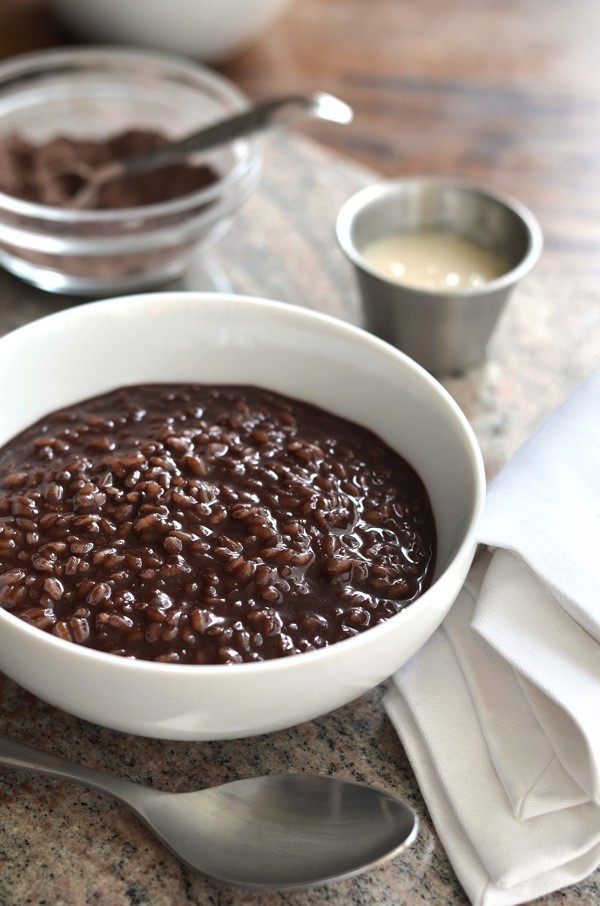
Champorado is a traditional Filipino breakfast consisting of rice, cocoa and milk. It is usually served hot and with a cup of iced coffee. It is usually served with small salty biscuits called “pandesal” and a slice of cheese.
The word “champorado” originates from the Spanish term “chocolate para desayunar”, meaning “breakfast chocolate”. It was first created by Maria Ylagan Briones in her bakery-restaurant called “El Progreso” in Nueva Ecija, Philippines. She was inspired by the popular Spanish dish “chocolate con churros.”
Later on this dish became very popular among Filipinos and spread to different parts of the country. There are variations of this meal depending on where you buy it from. For example, some people prefer their champorado to be sweet and others prefer it to be bland. The Filipino chocolate rice porridge with milk is made with evaporated milk, cocoa powder, and sugar then garnished with cheese and/or salted pandesal rolls or “pan de sal”.
Ube Pan De Sal

Ube Bread is a favorite food of Filipinos, particularly for breakfast.
The sweetness of the bread comes from ube which is a root crop that is commonly known as purple yam. The color of this bread, which ranges from light violet to dark violet, comes from the specific variety of ube used.
It can be eaten with just butter or dipped in garlic oil. One can also slice it up and toast it before serving. It will definitely satisfy your craving for sweets.
Longsilog

Longsilog is a meal. It can be eaten for breakfast or lunch.
Longsilog is made up of longganisa (a type of Filipino sausage), soy sauce, garlic fried rice and eggs on the side. The eggs can either be sunny-side up or scrambled eggs.
Sometimes people like to put some hot sauce in their longsilog to make it spicier.
Pandesal
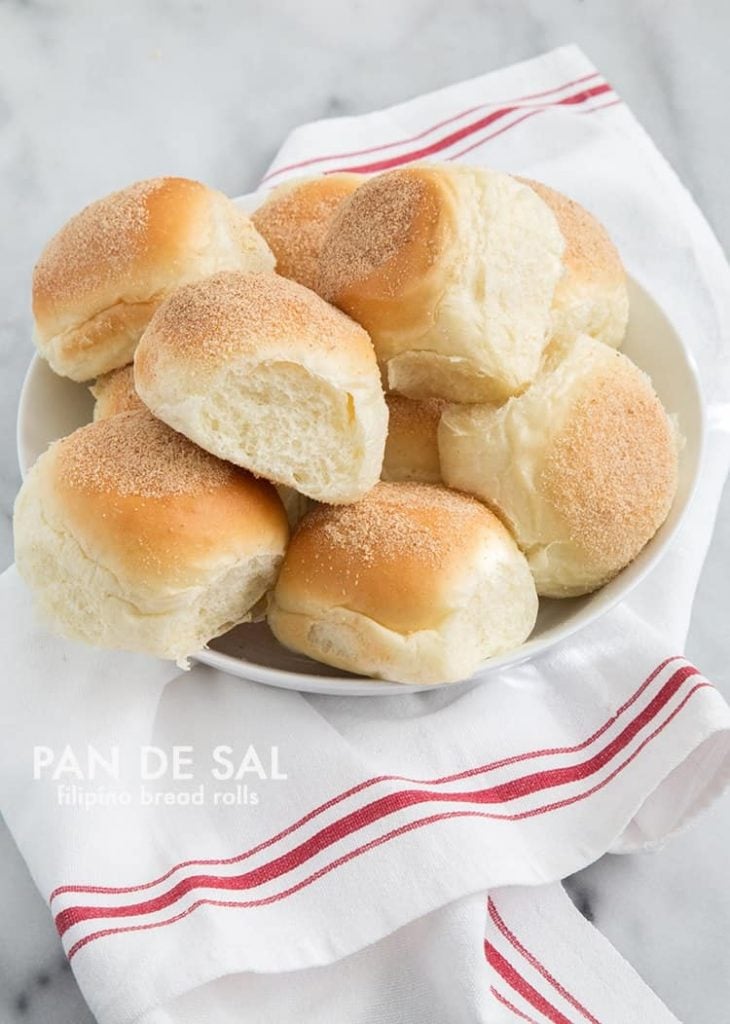
The pan de sal (literally “bread of salt”) is a Philippine-style bread typically sold at the many bakeries called panaderia and carinderias throughout the Philippines. It is made from wheat flour, eggs, yeast or baking powder, sugar, and salt.
Pan de sal is different from other traditional types of bread because it is not sweet, and is usually paired with salty toppings such as cheese, butter, or a thick sauce made from cured dried fish called daing.
The pan de sal has been featured in various Filipino novels and movies and has come to be an iconic symbol of the Philippine breakfast experience.
Ensaimada
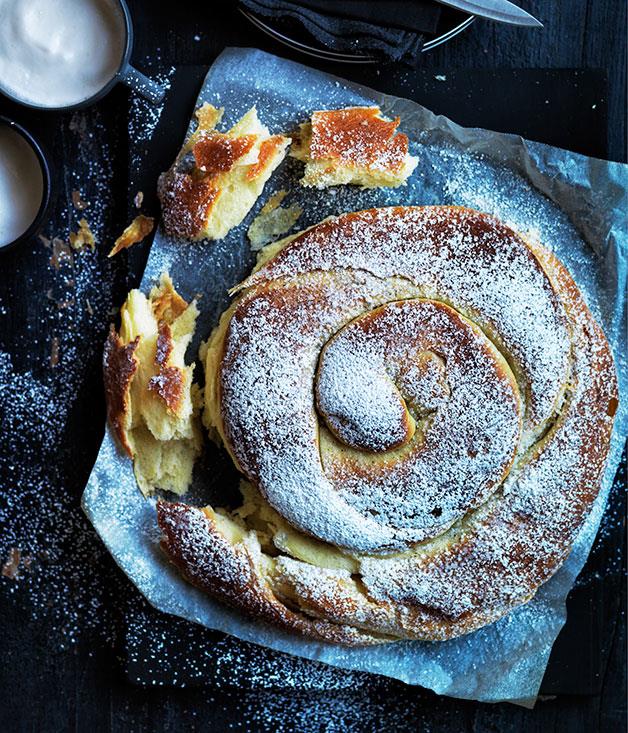
Ensaimada is a sweet bread. It is eaten for breakfast or snack.
It is made from flour, water, sugar, and yeast.
You can eat it by itself or with butter, raisins, or cheese on top of it.
It was especially popular during the 1960s and 1970s in all regions of the Philippines. These pastries can either be made at home or bought from a bakery or carinderia.
Filipino Lunch and Dinner Recipes
Filipinos also eat different types of food in the afternoon and in the evening. Dinner is usually the largest meal in the day and would consist of rice with chicken, fish, vegetables, pork or beef. It may be accompanied by a bowl of soup consisting mainly of noodles in clear broth.
Sometimes Filipinos might have some fried fish called “paba” made from palm treacle which is sweetened with sugar cane juice before being deep-fried.
There are also other dishes that Filipinos might have for dinner such as arroz caldo (congee), pancit malabon (manila-style noodles) or pansit canton (fried fish noodles), sinigang na baboy (pork/beef soup with tamarind), and dinuguan (pork blood stew).
Arroz Caldo

Arroz Caldo is a Filipino rice porridge that is traditionally made by boiling chicken, ginger and garlic in water. This infused stock is then simmered with spices such as peppercorns, cloves and cinnamon stick.
Once the meat is tender, adding ground white pepper or black pepper to taste with either bone marrow or chopped up pieces of chicken along with chopped up garlic, ginger and onions. Once the chicken is cooked through, adding in one part rice to two parts of stock or water and simmering until the rice softens.
It can be eaten by itself with a bit of kalamansi lime juice squeezed on top or fresh red chili pepper slivers (siling mahaba).
Filipino Fried Rice
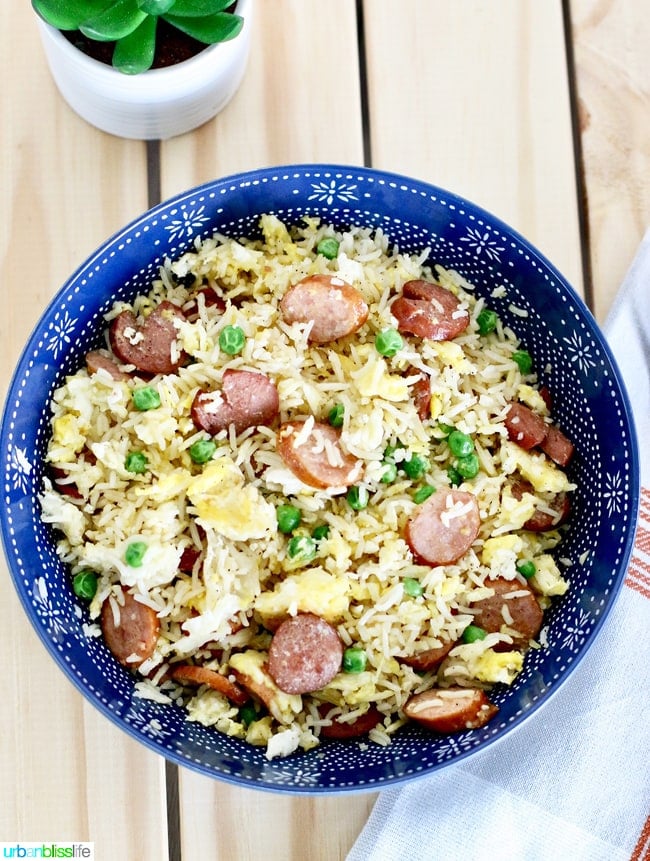
Filipino fried rice is a popular dish that consists of rice, peas, carrots, sausage, egg, and soy sauce all fried in a pan.
Sweet Spaghetti

Sweet spaghetti is a Filipino favorite spin on the traditional spaghetti dish. It is sweeter than the typical spaghetti Westerners eat and sometimes served with sausage instead of meatballs.
Pork Adobo
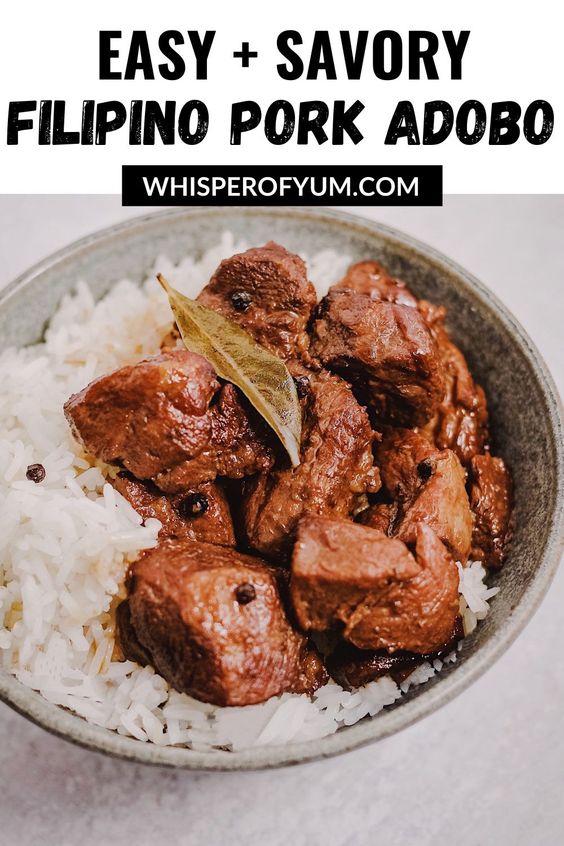
Pork Adobo is when pork is cooked in a mixture of soy sauce, vinegar, garlic, bay leaves, black peppercorns, and cinnamon sticks. The dish was originally popularized in various areas throughout the Philippines in the 16th century when Ferdinand Magellan introduced it to the natives.
The dish has become very popular throughout different regions in the country with preparations varying from region to region.
Pancit Palabok

Pancit Palabok is a Filipino noodle dish made with rice noodles, shrimp, pork strips, tomatoes, green onions, carrots, and various other vegetables. It is topped off with a special sauce made from fish or pork stock.
Kare-Kare

Kare kare is a traditional Filipino stew, which consists of peanut sauce flavored with beef broth and shrimp paste as principle ingredients, cooked with oxtail or beef tripe (tadyang), vegetables such as eggplant (aubergine), long beans (sundalo) and string beans (sitaw).
Sisig

Sisig is a Filipino dish of cooked and diced pork cooked in a mixture of vinegar, calamansi lime juice, garlic, ginger, pepper and other spices. It includes the pig’s head, liver or any part that would normally be used as sisig.
It can also include onions fried with garlic to flavor the dish. The meat is then boiled until tender and seasoned with different types of sauces such as soy sauce, calamansi lime juice, and banana catsup.
Sinangag (Garlic Fried Rice)

If you have never had fried rice before, you are definitely missing out! This recipe is a garlic variation of fried rice and is often eaten by Filipinos.
Filipino Desserts
Filipinos enjoy eating a wide variety of desserts with ingredients like coconut, ube, and bread. The most well-known and perhaps the most loved Filipino dessert is called Halo-Halo. This dessert name translates to English as ‘mix-mix’.
Halo-Halo

Halo-halo is a Filipino dessert that has many different layers. First, there is crushed ice and evaporated milk on the bottom. Next, there are sweetened beans called “pinipig” with purple yam (“ube”). Then there’s shaved ice with red beans (or other kinds of beans) and macapuno (coconut).
Different kinds of fruit are usually added to halo-halo. Berries, mangoes, and bananas cut into smaller pieces are put on top of it, as well. It is topped off with ube ice cream and a tiny drop of leche flan in the center.
Karioka

Karioka is a rice cake made with glutinous rice mixed with different ingredients, such as eggs, sugar, and other flavors. You can find it in many different colors or varieties.
Bibingka

Bibingka is a rice cake made from coconut milk and glutinous rice flour. It’s traditionally cooked by wrapping the dough in banana leaves and boiling it, making it soft before eating.
Suman

Suman is a round or cylindrical rice cake that can be found in the Philippines. It’s made from rice flour, sugar, and salt. The dough is traditionally wrapped in banana leaves and boiled to make it softer before being eaten.
Cassava Cake
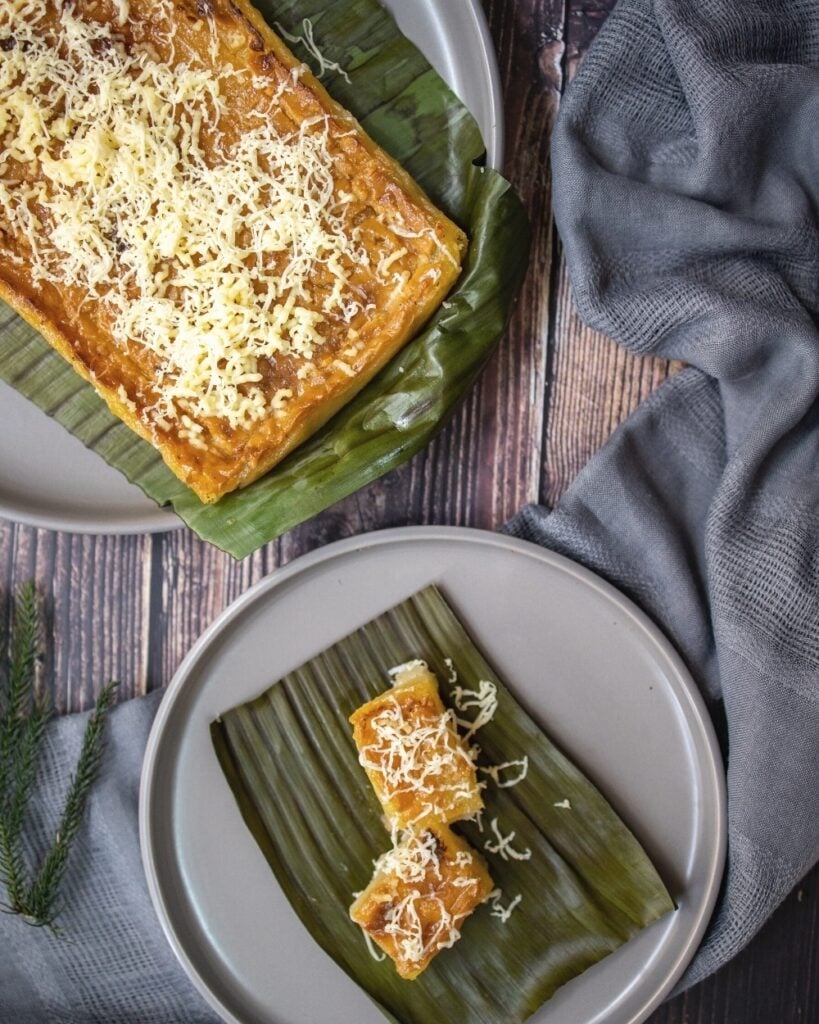
Cassava cake is made with cassava. Cassava is a type of plant that grows in the Philippines. It’s used to make this cake. You need to take the leaves off. Then you need to chop up the cassava, put it in a pot and boil it until cooked through.
Leche Flan

Leche flan is a sweet dessert made from eggs and milk. You can eat it with fruit or on its own.
Ube Ice Cream
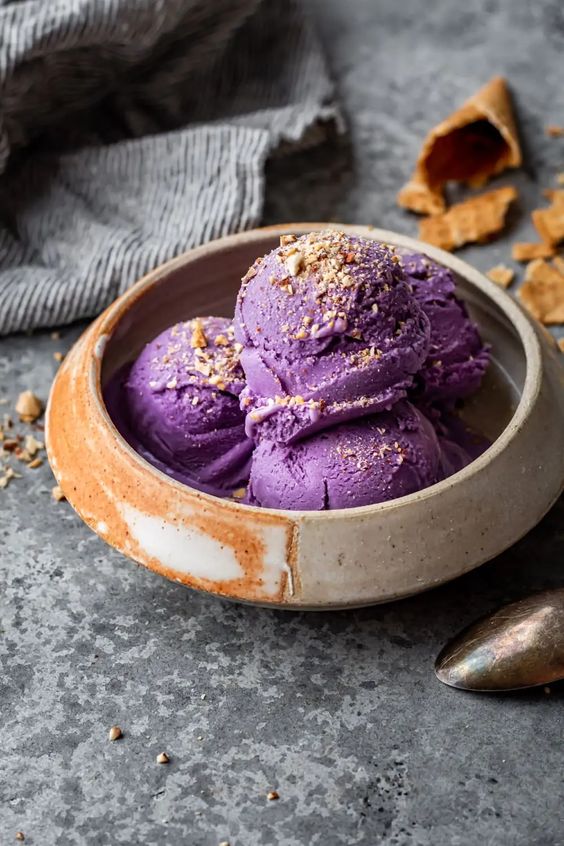
Ube (also known as malungay or purple yam) is the skin of the fruit. It is boiled and mashed before it’s frozen, giving it its signature taste. The ice cream is creamy with a strong flavor.
Turon

Turon is a Filipino dessert. It consists of a slice of sweetened banana or plantain, which is then wrapped in a thin egg crepe and deep-fried. The banana is stuffed with grated coconut and/or red beans. Sugar may be sprinkled on top before serving.
Filipino Food for Parties

There are many Filipino foods that people enjoy at parties. There’s pancit palabok, a noodle dish with shrimp and pork. Kare-kare is a Filipino stew with meat and vegetables like eggplant and string beans.
Sisig is a dish including chopped pork roast as well as onions fried with garlic, soy sauce, fried rice topped off with garlic and vinegar, and halo-halo, which has many different layers of ingredients such as shaved ice and macapuno (coconut).
Turon is a dessert consisting of a slice of sweetened banana wrapped in an egg crepe and deep-fried. All these dishes can be enjoyed at parties where Filipinos can share the foods that they love to eat.
When it comes time to decide what Filipino dish you should bring to the upcoming potluck, it depends on whether the host requested anything specific. If not, feel free to bring your favorite dish. The dishes listed below are common Filipino potluck foods that tend to run out quickly. Choosing any of these dishes will definitely be appreciated by your fellow party attendees!
Lechon Kawali

Lechon kawali is a popular dish in the Philippines. It is roasted pork that has been cooked and then fried in oil. It is served with vinegar and spicy chili sauce. It can be eaten as a side dish, or it can be an appetizer.
Pancit

Pancit is a Filipino dish that is made out of noodles, meat, vegetables, soy sauce, and other spices.
Lumpia

Lumpia is a Filipino dish that is made with egg, onion, cabbage, carrots, celery, and potatoes. The filling is wrapped in lumpia wrappers then deep-fried. Some people like to dip the finished product into soy sauce or sweet chili sauce.
Buko Salad

Buko salad is a Filipino dish. It’s made with shredded young coconut. The other ingredients are sweetened condensed milk, fruit cocktail, and cream.
Filipino Food Culture
What is Filipino food?
Filipino food is a combination of many different cultures and it is one of the most major influences of its own culture. It’s no wonder why Filipino cuisine has such a wide variety as there are more than 100 languages spoken in the country.
When you travel around Asia, you’ll find that there are a lot of similarities between their food throughout history, especially with cuisines from Japan and China. The Filipinos have also been influenced by these two countries due to being colonized by both Japan and China for decades during the past. There was even a period when the Philippines was under Portuguese occupation as well but they didn’t stay long enough to make much impact on their cuisine.
Due to its location in East Asia, Malaysia and Indonesia have influenced Filipino cuisine as well. The Philippines is geographically located near these two countries and they have been trading partners for a long time. There are many dishes in the Philippines that were influenced by Malaysia and Indonesia, such as Nasi Lemak (Filipino: Pandan Chicken) and Lumpia (Filipino: Eggrolls).
And of course, a large part of Filipino cuisine comes from their colonization by Spain. In fact, Spanish food is still very popular around the country today. Pan de Sal (Filipino: Salted Bread), for example, has become a staple bread eaten throughout the Philippines. When you think about it, it makes sense because most Asian countries had their own version of salted bread more than 2000 years ago. The Philippines version is simply adapted from European baking techniques and ingredients, using coconut milk and tropical fruits instead of butter and cold water available in Europe.
One interesting fact about Filipino food is that many dishes are boiled or fried due to the lack of large ovens throughout history. It doesn’t mean that they don’t have desserts though, as they actually have a ton of sweet delights.
As I mentioned before, there are so many different cultures living together in the Philippines, which influenced its cuisine just like any other nation with a similar story. But unlike other countries whose cultures revolve around only one type of cooking technique, Filipino culture revolves around many types of cooking methods. Their dishes are cooked by boiling, frying, baking, grilling/barbecuing, and steaming. It is interesting how each dish uses different methods on how the food is cooked.
Another thing to add about Filipino food culture is that it doesn’t have much of an influence from other countries in Southeast Asia because most cultures are Muslim and they normally don’t eat pork. These countries mainly consist of Malaysia, Indonesia, Brunei, Singapore, and Thailand. Only a small part of these cultures not being Muslim has allowed some influence to reach the Philippines but since its cuisine already has so many influences from other countries before that, their dishes were adjusted to fit their taste buds instead of modifying their own dishes to meet another’s taste buds like what happens in most cases with cultural cuisines.
Filipino Potlucks
A Filipino “potluck dinner” is where everyone contributes food to make the meal. For many Filipinos, this type of gathering is an opportunity to enjoy delicious home-cooked food with friends and family while catching up on the latest gossip. The dishing out of food typically happens in rapid succession so there’s no time to get bored of what’s on offer – particularly if there are different groups of people who have brought their own signature dishes to share.
For those who are accustomed to a certain amount of formality at mealtimes, this kind of casual atmosphere can come as a welcome change. You don’t have to worry about boring the pants off your dinner date with interminable monologues while you eat, nor do you need to be overly considerate of their dietary needs and special requirements for fear of offending them. Just bring yourself and enjoy!
If there’s one thing that characterizes most Filipino gatherings, it’s food; particularly if they turn out to be “potluck”. Gathering people together for food is in fact so integral to Philippine culture that there are several Tagalog words for these get-togethers: pakikipagkain (literally, “sharing food”) or kainan (“meal”).
I remember that Filipino potlucks happen when there’s a celebration of any kind, even just an ordinary day. It could be as simple as someone’s birthday or the 5th year anniversary of their marriage.
Filipinos are big on potlucks. People don’t really entertain guests at home with a sit-down dinner anymore, instead, we go for the easier way out of having everyone bring their own food to share. Everyone pitches in and it turns into a fun night for all!
As someone who has attended many Filipino potlucks over the years, I’ve found that they truly make for some of the best parties you can possibly go to because everyone is there to have a good time and eat! There’s no stress over who should bring what, how much to prepare or where everyone is going to sit. Plus you get a wide variety of food made with love by everyone involved, including your host(s)!
When it comes to Filipino potlucks, there are some guidelines that will make sure the event runs smoothly for all involved. Here are some helpful hints about how to be a good guest at a Filipino potluck:
Don’t worry about formality – Your role is to enjoy yourself and tuck into whatever delicious food your generous hosts and party attendees have prepared for you!
Don’t show up empty-handed – The joy of Filipino potlucks is the variety of foods available, courtesy of the guests. While hosts will typically provide some drinks and main dishes, it is important to contribute. A well-organized potluck will typically have food contributions assigned ahead of time.
Filipino Food in America
If you are wondering how Filipino food in American differs from its country of origin, check out the diagram above. Pinoy food prepared in the United States typically is served in larger portions, contains fewer vegetables, less rice, and more soda is consumed with meals.
I hope you enjoyed this blog post about Filipino food. If you haven’t tried any authentic Filipino recipes yet, you should cook some ASAP! Who knows? You might find your new favorite dish or learn something new about an interesting culture. Do you have a favorite Filipino recipe? Let me know in the comments below so we can all try it out together!


